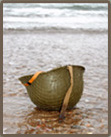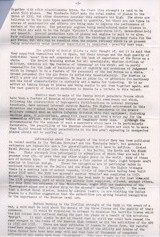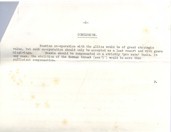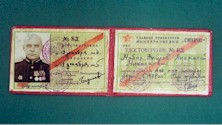The Cold War: KGB, CIA, and British Intelligence |
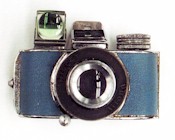 |
The Cold War and the spy craft that emerged are direct descendants of World War II. Just as Ian Fleming used his intelligence background from the early 1940's to create his fictional character James Bond as a Cold War-era secret agent, many of the artifacts in this section had their origins in World War II. Fleming himself is represented--with first-edition copies of his Bond novels, to his 'courier passport' from his first spy mission, to his typewriter used in Jamaica to type many of his James Bond novels. |
|
| |
 |
Ian Fleming's 'Courier Passport' for his first mission as an intelligence agent, from Madrid to London via Lisbon, February 1941. The code-name for this mission was "Goldeneye". |
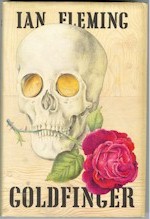 |
First-edition copy of Ian Fleming's Goldfinger |
|
| |
Ian Fleming’s seven-page report, “Russia’s Strength. Some Cautionary Notes.” Prepared April 25, 1939, it reported on the conditions in Russia immediately before the outbreak of the war. This is presumed to be Fleming’s first written intelligence report and led directly to his wartime career in naval intelligence. He included this in his report: “Russia would be an exceedingly treacherous ally. She would not hesitate to stab us in the back the moment it suited her. But not too much weight should be attached to the possibility of a Russo-German alliance at this moment.” |
|
| |
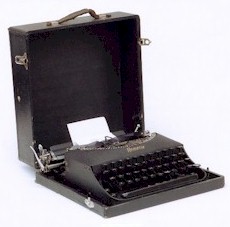 |
Ian Fleming’s portable typewriter, given to Prue Mason in 1956. The note from Fleming refers to him having told her that “Code Name Zoe” was a great title for a book. Fleming’s “Golden Typewriter” was used to write only one James Bond novel, Live and Let Die. This typewriter was carried back and forth to Jamaica where he wrote the other Bond thrillers. His house in Jamaica was called ‘Goldeneye’, the code name of his first mission for British Intelligence. His passport for that mission is above. |
|
| |
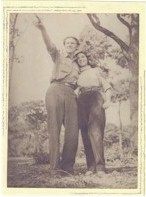 |
A great many of the artifacts found in the collection come from an extraordinary husband-and-wife collecting team, Peter and Prue Mason. |
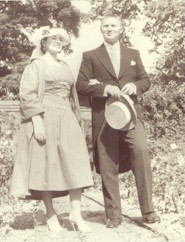 |
|
| |
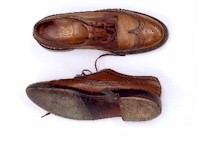 |
Shoes given to Peter Mason by James Jesus Angleton, who at the time was the Deputy Director of the CIA and was in charge of counterintelligence against the KGB. Serrated instep knife and heel dagger supplement steel soles for truly leaving an impression on an enemy in a fight. |
|
| |
BRITISH INTELLIGENCE ARTIFACTS |
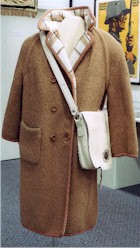 |
Prue Mason's reversible Alpaca topcoat contains a transferable leather holster for a .380 semi-automatic pistol. Her leather-lined handbag has a built-in holster for a .45 acp Colt, a spare magazine, and other weapons |
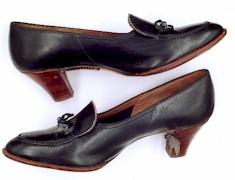 |
Prue Mason's shoes, fitted with a pivoting escape blade in the instep and a serrated stomping plate affixed in the other. |
|
| |
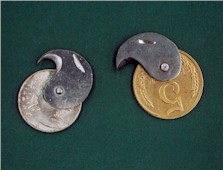 |
Escape coins with hidden blades, used to slash throats of captors. To the left is an 'I Halala' coin used in Saudi Arabia by Peter Mason. The coin to the right was used by Prue Mason while in Russia |
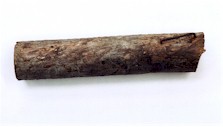 |
British Dead Letter Box, concealed within a fire-log. Used in Australia for the defection of KGB operative Vladimir Petrov in 1955. The usual modus operandi was for the nail to be set parallel to the sides of the log when left by a case officer, but across the log if signals were left by Petrov. |
|
| |
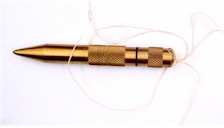 |
British Naval Intelligence dead-drop for use in deltas or low-lying areas. Made of waterproof polished brass to contain microfilm or documents, and supplied with imitation seaweed or grass. |
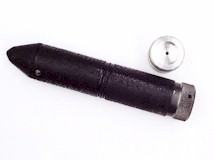 |
"One-Off" copy of KGB booby-trap dead-letter box for roll of 35mm film. It exploded, setting off a thermite well, burning the contents if opened by enemy agent, while likely blowing off agent's hands. |
|
| |
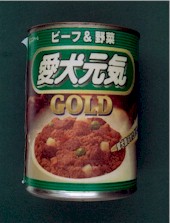 |
British Intelligence dead-letter box, disguised as a canned food container, fabricated for an operation in Hong Kong against Communist China in the 1970's |
 |
Prototype of 'Operation Foxley' pneumatic cyanide weapon, equipped with a safety pin with pull string attached to the ring of the firing rod |
|
| |
 |
Bitrex, used to destroy crops |
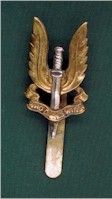 |
SAS ("Seek and Strike) officer's cap badge |
|
| |
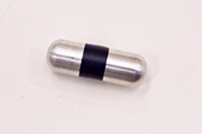 |
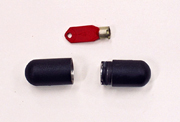 |
Suppository devices created to avoid detection during a search were used by spies of all nations. |
|
| |
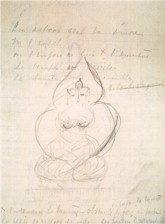 |
World War I spy Mata Hari was a double agent working for both the French and Germans. She was executed by the French. In this handwritten manuscript planning an exotic dance performance, she has sketched a self-portrait. |
|
| |
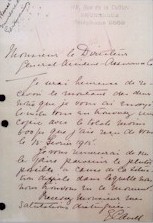 |
Edith Cavell was a World War I English nurse who assisted British, French and Belgian soldiers to escape to the Dutch border between 1914 and 1915. She was arrested by the Germans and executed. This letter is from 1915. |
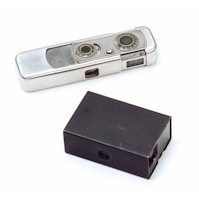 |
The legendary Minox camera was the best spy camera of the Cold War era. |
|
| |
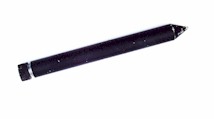 |
Dead-drop device for leaving microfilm |
|
| |
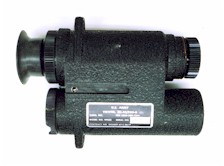 |
MeteScope: a hand-held, battery-operated infrared viewer |
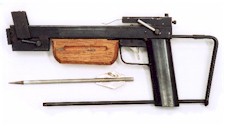 |
Crossbow and metal arrow |
|
| |
 |
Camera in a cigarette lighter |
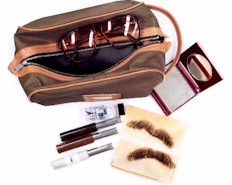 |
CIA disguise kit, circa 1982 |
|
| |
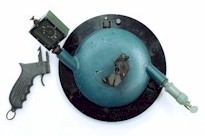 |
Limpet mine, designed to attach magnetically to a ship's hull. |
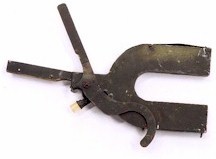 |
Shape charge, filled with explosives, that was designed to be attached to a ship's anchor. |
|
| |
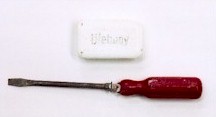 |
"Lifebuoy Soap" and screwdriver handle, both filled with incendiary devices. |
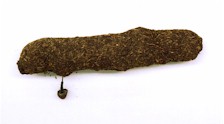 |
"Doggie Doo" transmitter device--a homing beacon whose camouflage is designed to discourage it from being moved. Circa 1970. |
|
| |
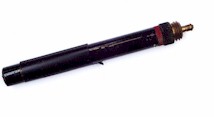 |
Gas pen |
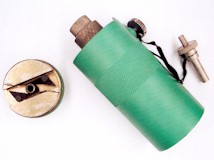 |
Thirty-day clock for explosives |
|
| |
 |
"The Bulgarian Umbrella" used a short-throw piston to implant a cyanide pellet just under the skin. Propelled ahead of the pellet would be Novocain jelly, causing an immediate local anesthetic sensation. The effect would be similar to a mosquito bite. A similar version of this umbrella was used to assassinate Georgi Markov, a defector and dissident, on a bridge in London. |
|
| |
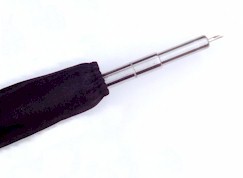 |
Close-up of the tip of the Bulgarian Umbrella. |
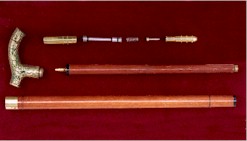 |
Assassin's walking stick, collected by Peter Mason. It was developed at KGB secret lab #12 and could fire cyanide or ricin. |
|
| |
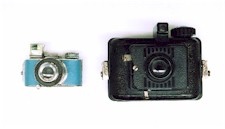 |
Cameras used by the KGB |
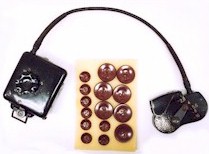 |
KGB buttonhole camera, with a set of buttons given to an agent so that he or she could replace one on a coat and install a camera behind it. It was activated by squeezing the lever, which would be concealed in a pocket. |
|
| |
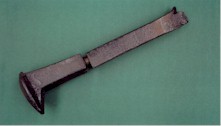 |
Railroad spike, used by the KGB as a money drop on a Canada/USA border crossing in the 1960's. |
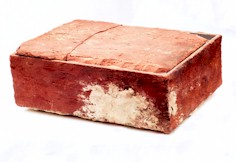 |
Hollowed brick, used as a hiding place |
|
| |
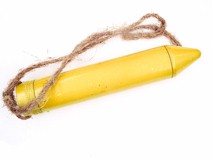 |
Russian 'SVR' dead-letter box, with push-button lock and O-ring seal. Painted yellow with special dog-deterrent type of paint normally used for gas detection. |
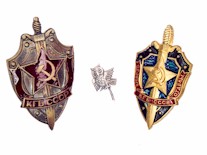 |
Soviet badges: from left--KGB badge, KGB elite police owl membership pin, and KGB special deparment badge |
|
| |
 |
Joseph Stalin, handwritten letter signed, March 27, 1930: "I read in an American newspaper about 'brutal atrocities' of the Bolsheviks....Funny people these American newspaper publishers. It's just downright comical....They make money with this notion of 'atrocities'." |
|
ID of a real SMERSH agent, 1945. |
|
| |
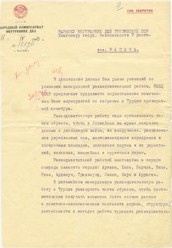 |
Lavrenty Beria. Handwritten letter, Moscow, October 9, 1938, to Joseph Stalin. Writing his first year as the head of the NVKD, Beria desperately tries to explain accusations made against him of anti-Soviet activities. He had worked in counterintelligence and had infiltrated an anti-Bolshevik group and he has been accused by his enemies of spying against the Bolsheviks.
""A number of Azerbaijan deviationist-Trotskyites, dissatisfied with the policy.were trying to discredit some of the party workers…including myself. Some provocative rumors were spread….
"All former 'Transcaucasians'…have now been unmasked as enem"
In 1953 Beria was executed by Stalin following his aborted attempt to overthrow his old ally. |
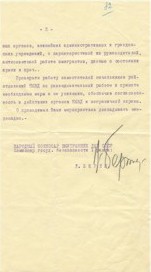 |
|
| |
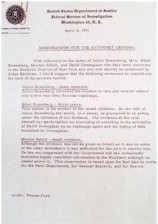 |
J.Edgar Hoover, giving details of his sentencing recommendations for the four principals in the Rosenberg espionage case involving stolen atomic secrets. Despite Hoover's comments for leniency, the Rosenbergs were both executed.
The KGB's greatest success was in stealing the secrets of the Atomic Bomb. Klaus Fuchs escaped to England, where he was arrested and given an relatively and amazingly light sentence. |
|
| |
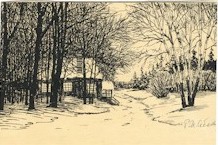 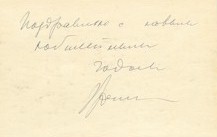 |
Rudolf Ivanovich Abel was a Soviet spymaster who operated for years within the United States. He was captured and eventually exchanged for American U2 pilot Francis Gary Powers. Abel signed one side of this postcard with his real name, Winifred, and wrote "Congratulations and Happy New Year". On the other side, he signed it with his alias, R. A. Abel. |
|

